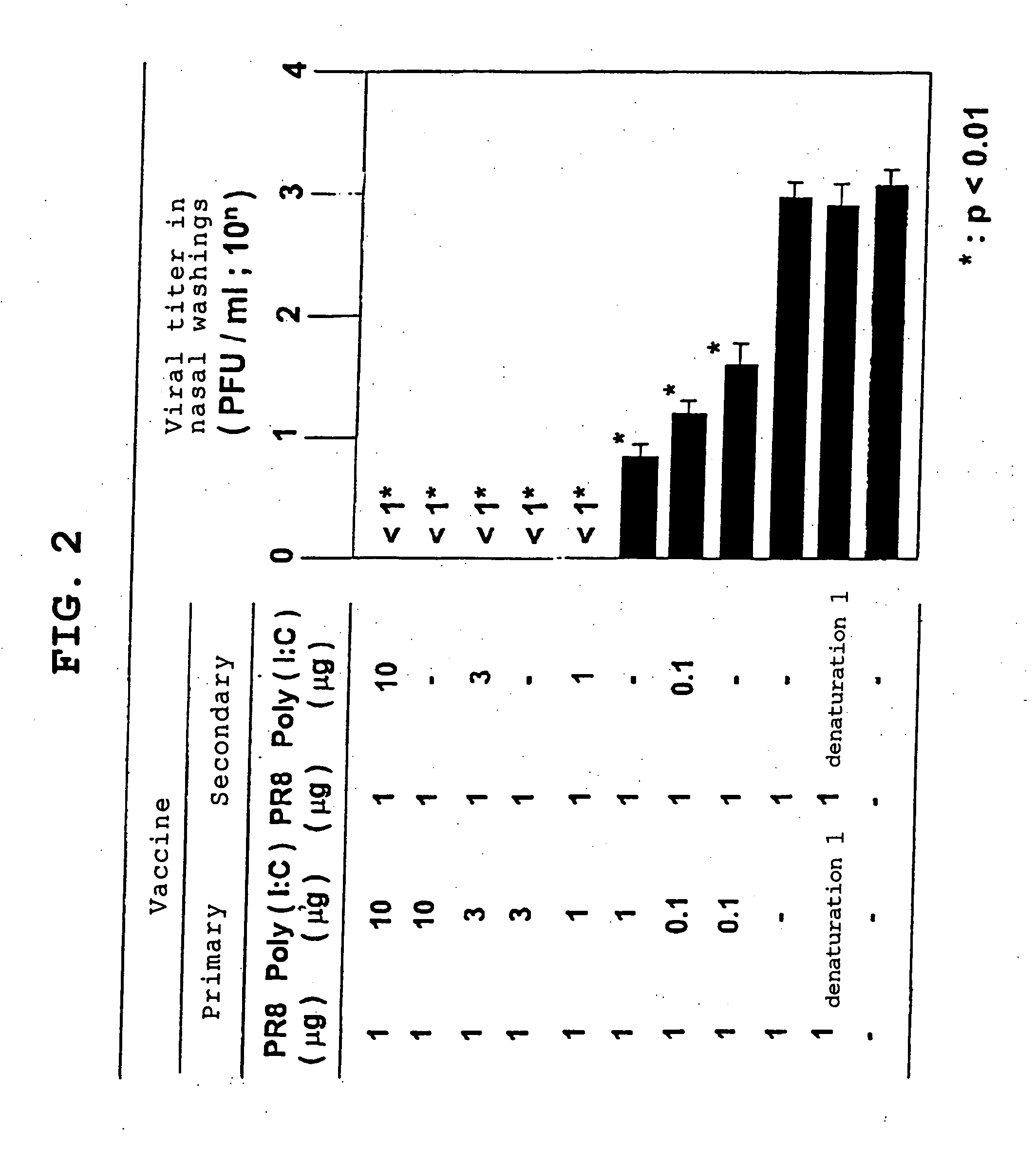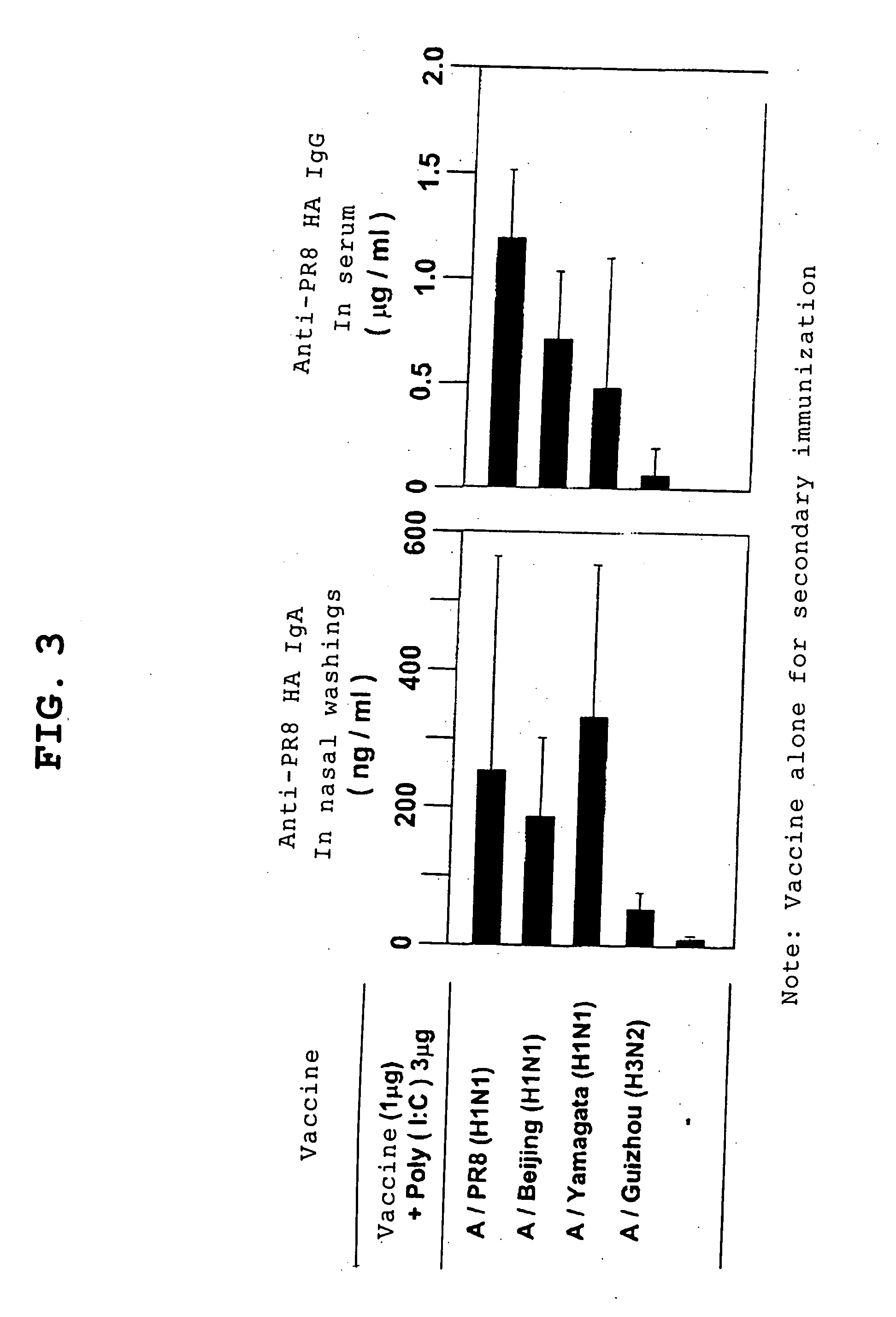Novel Vaccine Containing Adjuvant Capable Of Inducing Mucosal Immunity
a technology of adjuvant and vaccine, applied in the field of new vaccine composition, can solve the problems of mismatch between vaccines, reduced antibody titer, and need to be vaccinated every year, and achieve the effect of convenient vaccination, effective and efficient prophylactic measures
- Summary
- Abstract
- Description
- Claims
- Application Information
AI Technical Summary
Benefits of technology
Problems solved by technology
Method used
Image
Examples
example 1
Adjuvant Action of Poly(I:C), a Synthetic Double-stranded RNA)
[0101] In this Example, the neutralizing-antibody-inducing potential and hence infection-protective effect of an inactivated virus or subunit antigen was verified using Poly(I:C), a synthetic double-stranded RNA, as an adjuvant.
(Materials)
Mice: BALB / c mice (6 weeks of age, female)
Virus: Influenza virus H1N1 (A / PR8) strain (obtained from the National Institute of Infectious Diseases (1-23-1, Toyama, Shinjyuku-ku, Tokyo))
[0102] Vaccines: Influenza virus H1N1 (A / PR8) strain and H1N1 (A / Beijing) strain (National Institute of Infectious Diseases); H1N1 (A / Yamagata) strain (National Institute of Infectious Diseases); H3N2 (A / Guizhou) strain (National Institute of Infectious Diseases); ether-inactivated HA vaccine (Research Foundation for Microbial Diseases of Osaka University, 2-9-41, Yahatacho, Kan-onji, Kagawa Prefecture)
Adjuvants: CTB* (CTB (cholera toxin B subunit) containing 0.1% CT (cholera toxin) as a positive...
example 2
Protection Against Cross Infections Using nasal vaccines in combination with Poly(I:C)
[0114] Regarding protection against influenza viruses induced by nasal influenza vaccines in combination with Poly(I:C), the potentials for protection against cross infections were examined. Each of vaccines of influenza virus strains of subtypes different from PR8, i.e., H1N1 (A / Beijing) strain, H1N1 (Yamagata) strain, and H3N2 (A / Guizhou) strain, along with 3 μg of Poly(I:C), was inoculated for first immunization; four weeks later, the vaccine of the same strain alone was inoculated; two weeks later, animals were infected with 100 pfu of H1N1 (A / PR8) strain; three days later, IgA showing cross reactions with PR8 in nasal washings, and IgG in serum were measured, and protection against cross infections using the PR8 virus was examined.
[0115] As shown in FIGS. 3 and 4, both IgA and IgG responses were observed for the H1N1 (A / Beijing) strain and H1N1 (A / Yamagata) strain, which are of the same sub...
example 3
Central Nervous Safety of Poly(I:C)
[0117] When Poly(I:C) is used as a nasal vaccine for humans, central nervous safety is important because of the proximity of the nasal cavity to the brain. With this in mind, intracerebral inoculation to BALB / c mice was attempted to verify the safety of Poly(I:C). 0.25 μg. 2.5 μg, or 25 μg of Poly(I:C) was dissolved in 25 μl of PBS, and intracerebral inoculation was performed using a double-needle syringe. After inoculation, body weight changes were measured and survival was checked. For control, 25 μg, 10 μg, or 25 μg of CTB* (CTB comprising 0.1% CT) was dissolved in 25 μl of PBS and intracerebral inoculation was performed in the same manner.
[0118] As shown in FIG. 5, all mice in all Poly(I:C) intracerebral inoculation groups survived for 2 weeks or more, with only a body weight change of a 5% loss observed in the 25 μg inoculation group. On the other hand, in the groups receiving intracerebral inoculation of control CTB* (CTB with 0.1% CT), 1 / ...
PUM
| Property | Measurement | Unit |
|---|---|---|
| concentration | aaaaa | aaaaa |
| pH | aaaaa | aaaaa |
| pH | aaaaa | aaaaa |
Abstract
Description
Claims
Application Information
 Login to View More
Login to View More - R&D
- Intellectual Property
- Life Sciences
- Materials
- Tech Scout
- Unparalleled Data Quality
- Higher Quality Content
- 60% Fewer Hallucinations
Browse by: Latest US Patents, China's latest patents, Technical Efficacy Thesaurus, Application Domain, Technology Topic, Popular Technical Reports.
© 2025 PatSnap. All rights reserved.Legal|Privacy policy|Modern Slavery Act Transparency Statement|Sitemap|About US| Contact US: help@patsnap.com



